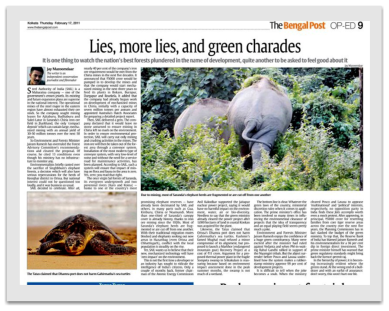

 forest rights, conservation and dilemmas of growth
forest rights, conservation and dilemmas of growth
 © mazoomdaar 2011
© mazoomdaar 2011

Lies, more lies, green lies
It is one thing to watch the nation's best forests plundered, quite another to be asked to feel good about it
Jay Mazoomdaar | 17 Feb, 2011 | THE BENGAL POST, pg9
Steel Authority of India is a maharatna company - one of the
government's crown jewels. Its existing and future expansion plans
are supreme in the national interest. The operational mines of the
steel major in the eastern region have almost exhausted their ore
stock. So the company sought mining leases for Ajitaburu,
Budhaburu and Sukri-Latur in Saranda's Chiria iron ore field, the
only "compact deposit" which can sustain large, mechanised mining
with an annual yield of 30-50 million tonnes over the next 50 years.
So Environment and Forests minister Jairam Ramesh has overruled
the Forest Advisory Committee's recommendations and cleared the
proposal. Of course, he cited 13 conditions even though his ministry
has no infrastructure to monitor any.
Environmentalists briefly ranted over the sacrifice of Singhbhum's
elephant forests, a decision which will also have serious
repercussions for the herds of the Keonjhar district in Orissa. But
national interest cannot be questioned too loudly and it was business as usual.
Then SAIL decided to celebrate. After all, nearly 40 per cent of the company's iron ore requirement would be met from Chiria mines in
the next five decades. It announced that Rs 5000 crore would be pumped in to develop the mines in Chiria and that the company would
start mechanised mining in the next three years to feed its plants in Bokaro, Burnpur, Durgapur and Rourkela. It added that the company
had already begun work on development of mechanised mines in Chiria, initially with a capacity of seven million tonnes per annum and
appointed Australia's Hatch Associates for preparing a detailed project report.
Then, SAIL delivered a gem. The company declared that it would leave no stone unturned to ensure mining in Chiria left no mark on the
environment. In order to ensure environmental protection, SAIL will carry out only mining and crushing activities in the mines. The iron
ore will then be taken out of the forest area through a conveyor system. Installation of the most modern type of conveyor system, with
very low-level of noise and without the need for a service road for maintenance activities, has been planned. According to SAIL, such a
system will ensure that impact of mining on flora and fauna in the area is zero. Yes, zero; you read that right.
The once virgin sal forests of Saranda, its evergreen undergrowth and two perennial rivers (Karo and Koina) - home to one of the
country's most promising elephant reserves -- have already been decimated by SAIL and others in many parts, such as, Gua, Kiriburu,
Chiria or Noamundi. More than one-third of Saranda's canopy cover is already history, thanks to iron ore mining since the 1920s. Most
of Saranda's elephant herds are fragmented or are cut off from one another. With their traditional migration routes blocked and
elephants seeking out new areas in Hazaribag (even Orissa and Chhattisgarh), conflict with the local population is steadily on the rise.
Yet, SAIL wants us to believe that their new, mechanized technology will have "zero impact" on the environment.
This is not the first time a developer or an industry has sought to ridicule the intelligence of India's citizens. Only a couple of months
back, former chairman of Atomic Energy Commission Anil Kakodkar supported the Jaitapur nuclear power project, saying it would have
no harmful impact on the environment, water, air or bio-diversity. Needless to say that the green ministry already cleared the power
project after 1,000 ha of land in the coastal Konkan was acquired for the plant.
Likewise, the Tatas claimed that Dhamra port does not harm Gahirmatha's sea turtles. Kashmir's famed Mughal road refused a minor
compromise of its alignment but proposed to launch a Markhor (endangered mountain goat) Recovery Project at a cost of Rs 11 crore.
Argument for a proposed thermal power plant in the fragile Sompeta swamp in Srikakulam is reassuring because based on environment
impact assessment done in the peak summer months, the swamp is not much of a wetland. The list is long.
The bottomline, however, is clear. Whatever the green laws of the country, ministerial discretion rules when it comes to application. The
prime minister's office has been involved so many times in influencing the environmental clearance of projects that the idea of
transparency and an equal playing field seems pretty much a joke.
Environment and Forests minister Jairam Ramesh enjoys the confidence of a huge green constituency. Many were excited after the
minister had ruled against Vedanta and when PM-in-waiting Rahul Gandhi rallied in support of the Niyamgiri tribals. But the abject
surrender before Posco and Lavasa underlined how the system makes a rubber-stamp ministry approve 99 per cent of development
projects.
It is difficult to tell when the joke becomes a snub. When the ministry cleared Posco and Lavasa to appease 'multinational' and 'political'
interests, respectively, no Opposition party in India finds these faits accomplis worth even a mock protest. After approving, in principal,
Rs 5000 crore for resettling families from core tiger reserve areas across the country over the next five years, the Planning Commission
has in fact slashed the budget of the green ministry. To top that, the Reserve Bank of India has blamed Jairam Ramesh and his
environmentalism for a 36% dip in foreign direct investment. The prime minister himself has warned that green regulatory standards
might bring back the licence-permit raj.
In the hierarchy of power, it is becoming increasingly evident where the greens stand. At the wrong end of a bulldozer and with an earful
of assurance: don't worry, this won't hurt one bit.
The author is an independent journalist







 Home | Reports | Related Articles | Resources | Gallery | Feedback | Contact | About
Home | Reports | Related Articles | Resources | Gallery | Feedback | Contact | About














 Home | Reports | Related Articles | Resources | Gallery | Feedback | Contact | About
Home | Reports | Related Articles | Resources | Gallery | Feedback | Contact | About














